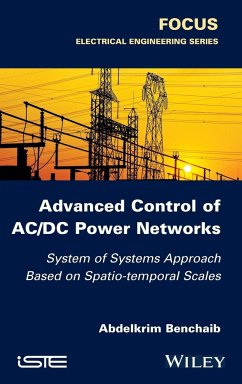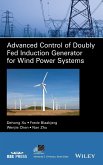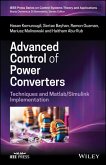Abdelkrim Benchaib
Advanced Control of AC / DC Power Networks
System of Systems Approach Based on Spatio-Temporal Scales
Abdelkrim Benchaib
Advanced Control of AC / DC Power Networks
System of Systems Approach Based on Spatio-Temporal Scales
- Gebundenes Buch
- Merkliste
- Auf die Merkliste
- Bewerten Bewerten
- Teilen
- Produkt teilen
- Produkterinnerung
- Produkterinnerung
The power engineering domain is facing huge challenges, with an increasing interest in intermittent renewable energies which are imposing major technical limitations. Operating ever closer to their limits, the industry-standard AC power grids are subject to instabilities. This book presents an insight into DC grid systems, offering interesting issues to well controlled power grids, in contrast to current AC systems which provide the simplest and most economic connection method for short distances.
Andere Kunden interessierten sich auch für
![High-Power Converters and AC Drives High-Power Converters and AC Drives]() Bin WuHigh-Power Converters and AC Drives166,99 €
Bin WuHigh-Power Converters and AC Drives166,99 €![Advanced Control of Doubly Fed Induction Generator for Wind Power Systems Advanced Control of Doubly Fed Induction Generator for Wind Power Systems]() Dehong XuAdvanced Control of Doubly Fed Induction Generator for Wind Power Systems159,99 €
Dehong XuAdvanced Control of Doubly Fed Induction Generator for Wind Power Systems159,99 €![Control of Single-Phase AC-DC Converters with High Power Factor Control of Single-Phase AC-DC Converters with High Power Factor]() Konstantin LouganskiControl of Single-Phase AC-DC Converters with High Power Factor35,99 €
Konstantin LouganskiControl of Single-Phase AC-DC Converters with High Power Factor35,99 €![Advanced Solutions in Power Systems Advanced Solutions in Power Systems]() Advanced Solutions in Power Systems190,99 €
Advanced Solutions in Power Systems190,99 €![Advanced Control of Power Converters Advanced Control of Power Converters]() Hasan KomurcugilAdvanced Control of Power Converters144,99 €
Hasan KomurcugilAdvanced Control of Power Converters144,99 €![Modeling and Modern Control of Wind Power Modeling and Modern Control of Wind Power]() Modeling and Modern Control of Wind Power158,99 €
Modeling and Modern Control of Wind Power158,99 €![Advanced DC/AC Inverters Advanced DC/AC Inverters]() Fang Lin LuoAdvanced DC/AC Inverters122,99 €
Fang Lin LuoAdvanced DC/AC Inverters122,99 €-
-
-
The power engineering domain is facing huge challenges, with an increasing interest in intermittent renewable energies which are imposing major technical limitations. Operating ever closer to their limits, the industry-standard AC power grids are subject to instabilities. This book presents an insight into DC grid systems, offering interesting issues to well controlled power grids, in contrast to current AC systems which provide the simplest and most economic connection method for short distances.
Hinweis: Dieser Artikel kann nur an eine deutsche Lieferadresse ausgeliefert werden.
Hinweis: Dieser Artikel kann nur an eine deutsche Lieferadresse ausgeliefert werden.
Produktdetails
- Produktdetails
- Verlag: Wiley
- Seitenzahl: 164
- Erscheinungstermin: 5. Oktober 2015
- Englisch
- Abmessung: 240mm x 161mm x 14mm
- Gewicht: 422g
- ISBN-13: 9781848218024
- ISBN-10: 1848218028
- Artikelnr.: 42584536
- Herstellerkennzeichnung
- Libri GmbH
- Europaallee 1
- 36244 Bad Hersfeld
- gpsr@libri.de
- Verlag: Wiley
- Seitenzahl: 164
- Erscheinungstermin: 5. Oktober 2015
- Englisch
- Abmessung: 240mm x 161mm x 14mm
- Gewicht: 422g
- ISBN-13: 9781848218024
- ISBN-10: 1848218028
- Artikelnr.: 42584536
- Herstellerkennzeichnung
- Libri GmbH
- Europaallee 1
- 36244 Bad Hersfeld
- gpsr@libri.de
Abdelkrim BENCHAIB received his PhD from the Automatic Systems Laboratory, Picardie University, France, in December 1998 and in 2014 his HDR (French post-doctoral degree allowing its holder to supervise PhD students)" from Paris-Orsay University. He joined ALSTOM in July 2000 where he is a power quality and smart grid project leader. Abdelkrim is seconded to work with the SupeGrid institute where he is an R&D group manager for real-time strategies for super grids protection,control and dispatch. His expertise and research interests include automatic control, power network, power electronics, power quality and smart grids issues as well as DC grid. Abdelkrim BENCHAIB is the "control chapter" chairman of the European Power Electronics and Drives (EPE) Association. Through the Control Chapter, Abdelkrim will be organizing events (seminars, workshops, conference, etc) and influencing technical exchanges to facilitate greater industrial/academic partnerships and to encourage the exchange of ideas to promote a greater understanding of Control and its future. In addition to his influencing role with EPE, Abdelkrim is also part (expert) of the French Evaluation Agency for Research and Teaching (AERES) . Abdelkrim BENCHAIB is associate Professor at the CNAM (Conservatoire National des Arts et Métiers) teaching wind energy and power network.
FOREWORD ix
PREFACE xi
LIST OF FIGURES xiii
LIST OF TABLES xvii
INTRODUCTION xix
CHAPTER 1. MODELING CONTROL OF VSCS 1
1.1. Introduction 1
1.2. Steady state voltage control systems - multi-terminal direct current
(VSC-MTDC) model 3
1.2.1. Convention 4
1.2.2. DC side model 5
1.2.3. DC power flow calculation 5
1.2.4. AC side model 6
1.3. Control system of VSC based on VOC 8
1.3.1. Inner current controller 10
1.3.2. Outer power controller 11
1.3.3. DC voltage controller 13
1.4. Conclusion 15
CHAPTER 2. TIME SCALE TOOLS: A CONTROL SOLUTION FOR MTDC COMPLEX SYSTEMS
WITH PLUG-AND-PLAY REQUIREMENTS 17
2.1. Introduction 17
2.2. Recalling VSC-HVDC control objectives 18
2.3. DC voltage control strategies for MTDC grids 20
2.3.1. Slack bus control (master/slave control) 21
2.3.2. Voltage margin control 22
2.3.3. Droop control 24
2.3.4. Dead-band-droop control 28
2.3.5. Undead-band-droop-control 29
2.3.6. Priority control 30
2.3.7. Ratio control 30
2.3.8. DC voltage control strategy summary 31
2.4. DC grid steady state modeling 32
2.5. Newton-Raphson technique 35
2.6. DC power flow 36
2.6.1. The first method: for master/slave control strategy 37
2.6.2. The second method (for a droop control): generalized approach 42
2.6.3. Generalized power flow for multi-terminal DC grids with more than
one slack bus 45
2.7. Steady state control of multi-terminal DC grids 45
2.7.1. Normal operation (without fault) 46
2.7.2. Power-step-change with master/slave strategy of control 48
2.7.3. Voltage margin control 49
2.7.4. Power-step-change for a voltage/power droop control 51
2.8. Primary and secondary control strategies 52
2.9. Dynamic control of multi-terminal DC grids 54
2.10. Plug-and-play in interconnected systems: application to MTDC grids 55
2.11. Control of the actuators connected to the power system 55
2.12. Concluding remarks 56
CHAPTER 3. FROM SMALL SIGNAL TO EXACT LINEARIZATION OF SWING EQUATIONS 57
3.1. Introduction 57
3.2. Recalling stability analysis tools 62
3.2.1. Small signal analysis - first method of Lyapunov 63
3.2.2. Transient stability 63
3.2.3. Global stability 66
3.2.4. Summary of stability approaches 66
3.3. Modeling of AC power network - swing equation 67
3.3.1. Nonlinear swing equation 68
3.3.2. Linearized swing equation 70
3.3.3. Development of the electrical power term 72
3.4. Simulation of AC swing equation 74
3.4.1. Post-fault simulation case (transient response) 77
3.5. Revisited swing equation for multi-machines power system modeling 82
3.6. Exact linearization of swing equation 83
3.7. Concluding remarks 85
CHAPTER 4. SPACE SCALE PROPERTIES FOR AC/DC POWER NETWORK CONTROL AND
OPERATIONS: NEW AGGREGATION METHODS IN POWER SYSTEMS 87
4.1. Introduction 87
4.2. Inter-area oscillation damping: locally intelligent substation 88
4.3. Free of space-scale model for AC systems: model reduction 92
4.3.1. Average model for N station multi-terminal systems: aggregated power
system 92
4.3.2. Free of space-scale model for inter-region application 94
4.4. Modeling of DC power networks 99
4.4.1. Mathematical approach of two terminal DC grid modeling 99
4.4.2. Multi-terminal DC (MTDC) grid modeling: generalized MTDC model 101
4.4.3. Toward DC swing equation 102
4.4.4. Development of the electric power term Pe 104
4.4.5. AC and DC "swing equations" equivalence 104
4.5. AC/DC converter control to mimic synchronous generators 105
4.6. Concluding remarks 107
CONCLUSION 109
APPENDICES 113
APPENDIX 1 115
APPENDIX 2 117
APPENDIX 3 121
BIBLIOGRAPHY 123
INDEX 129
PREFACE xi
LIST OF FIGURES xiii
LIST OF TABLES xvii
INTRODUCTION xix
CHAPTER 1. MODELING CONTROL OF VSCS 1
1.1. Introduction 1
1.2. Steady state voltage control systems - multi-terminal direct current
(VSC-MTDC) model 3
1.2.1. Convention 4
1.2.2. DC side model 5
1.2.3. DC power flow calculation 5
1.2.4. AC side model 6
1.3. Control system of VSC based on VOC 8
1.3.1. Inner current controller 10
1.3.2. Outer power controller 11
1.3.3. DC voltage controller 13
1.4. Conclusion 15
CHAPTER 2. TIME SCALE TOOLS: A CONTROL SOLUTION FOR MTDC COMPLEX SYSTEMS
WITH PLUG-AND-PLAY REQUIREMENTS 17
2.1. Introduction 17
2.2. Recalling VSC-HVDC control objectives 18
2.3. DC voltage control strategies for MTDC grids 20
2.3.1. Slack bus control (master/slave control) 21
2.3.2. Voltage margin control 22
2.3.3. Droop control 24
2.3.4. Dead-band-droop control 28
2.3.5. Undead-band-droop-control 29
2.3.6. Priority control 30
2.3.7. Ratio control 30
2.3.8. DC voltage control strategy summary 31
2.4. DC grid steady state modeling 32
2.5. Newton-Raphson technique 35
2.6. DC power flow 36
2.6.1. The first method: for master/slave control strategy 37
2.6.2. The second method (for a droop control): generalized approach 42
2.6.3. Generalized power flow for multi-terminal DC grids with more than
one slack bus 45
2.7. Steady state control of multi-terminal DC grids 45
2.7.1. Normal operation (without fault) 46
2.7.2. Power-step-change with master/slave strategy of control 48
2.7.3. Voltage margin control 49
2.7.4. Power-step-change for a voltage/power droop control 51
2.8. Primary and secondary control strategies 52
2.9. Dynamic control of multi-terminal DC grids 54
2.10. Plug-and-play in interconnected systems: application to MTDC grids 55
2.11. Control of the actuators connected to the power system 55
2.12. Concluding remarks 56
CHAPTER 3. FROM SMALL SIGNAL TO EXACT LINEARIZATION OF SWING EQUATIONS 57
3.1. Introduction 57
3.2. Recalling stability analysis tools 62
3.2.1. Small signal analysis - first method of Lyapunov 63
3.2.2. Transient stability 63
3.2.3. Global stability 66
3.2.4. Summary of stability approaches 66
3.3. Modeling of AC power network - swing equation 67
3.3.1. Nonlinear swing equation 68
3.3.2. Linearized swing equation 70
3.3.3. Development of the electrical power term 72
3.4. Simulation of AC swing equation 74
3.4.1. Post-fault simulation case (transient response) 77
3.5. Revisited swing equation for multi-machines power system modeling 82
3.6. Exact linearization of swing equation 83
3.7. Concluding remarks 85
CHAPTER 4. SPACE SCALE PROPERTIES FOR AC/DC POWER NETWORK CONTROL AND
OPERATIONS: NEW AGGREGATION METHODS IN POWER SYSTEMS 87
4.1. Introduction 87
4.2. Inter-area oscillation damping: locally intelligent substation 88
4.3. Free of space-scale model for AC systems: model reduction 92
4.3.1. Average model for N station multi-terminal systems: aggregated power
system 92
4.3.2. Free of space-scale model for inter-region application 94
4.4. Modeling of DC power networks 99
4.4.1. Mathematical approach of two terminal DC grid modeling 99
4.4.2. Multi-terminal DC (MTDC) grid modeling: generalized MTDC model 101
4.4.3. Toward DC swing equation 102
4.4.4. Development of the electric power term Pe 104
4.4.5. AC and DC "swing equations" equivalence 104
4.5. AC/DC converter control to mimic synchronous generators 105
4.6. Concluding remarks 107
CONCLUSION 109
APPENDICES 113
APPENDIX 1 115
APPENDIX 2 117
APPENDIX 3 121
BIBLIOGRAPHY 123
INDEX 129
FOREWORD ix
PREFACE xi
LIST OF FIGURES xiii
LIST OF TABLES xvii
INTRODUCTION xix
CHAPTER 1. MODELING CONTROL OF VSCS 1
1.1. Introduction 1
1.2. Steady state voltage control systems - multi-terminal direct current
(VSC-MTDC) model 3
1.2.1. Convention 4
1.2.2. DC side model 5
1.2.3. DC power flow calculation 5
1.2.4. AC side model 6
1.3. Control system of VSC based on VOC 8
1.3.1. Inner current controller 10
1.3.2. Outer power controller 11
1.3.3. DC voltage controller 13
1.4. Conclusion 15
CHAPTER 2. TIME SCALE TOOLS: A CONTROL SOLUTION FOR MTDC COMPLEX SYSTEMS
WITH PLUG-AND-PLAY REQUIREMENTS 17
2.1. Introduction 17
2.2. Recalling VSC-HVDC control objectives 18
2.3. DC voltage control strategies for MTDC grids 20
2.3.1. Slack bus control (master/slave control) 21
2.3.2. Voltage margin control 22
2.3.3. Droop control 24
2.3.4. Dead-band-droop control 28
2.3.5. Undead-band-droop-control 29
2.3.6. Priority control 30
2.3.7. Ratio control 30
2.3.8. DC voltage control strategy summary 31
2.4. DC grid steady state modeling 32
2.5. Newton-Raphson technique 35
2.6. DC power flow 36
2.6.1. The first method: for master/slave control strategy 37
2.6.2. The second method (for a droop control): generalized approach 42
2.6.3. Generalized power flow for multi-terminal DC grids with more than
one slack bus 45
2.7. Steady state control of multi-terminal DC grids 45
2.7.1. Normal operation (without fault) 46
2.7.2. Power-step-change with master/slave strategy of control 48
2.7.3. Voltage margin control 49
2.7.4. Power-step-change for a voltage/power droop control 51
2.8. Primary and secondary control strategies 52
2.9. Dynamic control of multi-terminal DC grids 54
2.10. Plug-and-play in interconnected systems: application to MTDC grids 55
2.11. Control of the actuators connected to the power system 55
2.12. Concluding remarks 56
CHAPTER 3. FROM SMALL SIGNAL TO EXACT LINEARIZATION OF SWING EQUATIONS 57
3.1. Introduction 57
3.2. Recalling stability analysis tools 62
3.2.1. Small signal analysis - first method of Lyapunov 63
3.2.2. Transient stability 63
3.2.3. Global stability 66
3.2.4. Summary of stability approaches 66
3.3. Modeling of AC power network - swing equation 67
3.3.1. Nonlinear swing equation 68
3.3.2. Linearized swing equation 70
3.3.3. Development of the electrical power term 72
3.4. Simulation of AC swing equation 74
3.4.1. Post-fault simulation case (transient response) 77
3.5. Revisited swing equation for multi-machines power system modeling 82
3.6. Exact linearization of swing equation 83
3.7. Concluding remarks 85
CHAPTER 4. SPACE SCALE PROPERTIES FOR AC/DC POWER NETWORK CONTROL AND
OPERATIONS: NEW AGGREGATION METHODS IN POWER SYSTEMS 87
4.1. Introduction 87
4.2. Inter-area oscillation damping: locally intelligent substation 88
4.3. Free of space-scale model for AC systems: model reduction 92
4.3.1. Average model for N station multi-terminal systems: aggregated power
system 92
4.3.2. Free of space-scale model for inter-region application 94
4.4. Modeling of DC power networks 99
4.4.1. Mathematical approach of two terminal DC grid modeling 99
4.4.2. Multi-terminal DC (MTDC) grid modeling: generalized MTDC model 101
4.4.3. Toward DC swing equation 102
4.4.4. Development of the electric power term Pe 104
4.4.5. AC and DC "swing equations" equivalence 104
4.5. AC/DC converter control to mimic synchronous generators 105
4.6. Concluding remarks 107
CONCLUSION 109
APPENDICES 113
APPENDIX 1 115
APPENDIX 2 117
APPENDIX 3 121
BIBLIOGRAPHY 123
INDEX 129
PREFACE xi
LIST OF FIGURES xiii
LIST OF TABLES xvii
INTRODUCTION xix
CHAPTER 1. MODELING CONTROL OF VSCS 1
1.1. Introduction 1
1.2. Steady state voltage control systems - multi-terminal direct current
(VSC-MTDC) model 3
1.2.1. Convention 4
1.2.2. DC side model 5
1.2.3. DC power flow calculation 5
1.2.4. AC side model 6
1.3. Control system of VSC based on VOC 8
1.3.1. Inner current controller 10
1.3.2. Outer power controller 11
1.3.3. DC voltage controller 13
1.4. Conclusion 15
CHAPTER 2. TIME SCALE TOOLS: A CONTROL SOLUTION FOR MTDC COMPLEX SYSTEMS
WITH PLUG-AND-PLAY REQUIREMENTS 17
2.1. Introduction 17
2.2. Recalling VSC-HVDC control objectives 18
2.3. DC voltage control strategies for MTDC grids 20
2.3.1. Slack bus control (master/slave control) 21
2.3.2. Voltage margin control 22
2.3.3. Droop control 24
2.3.4. Dead-band-droop control 28
2.3.5. Undead-band-droop-control 29
2.3.6. Priority control 30
2.3.7. Ratio control 30
2.3.8. DC voltage control strategy summary 31
2.4. DC grid steady state modeling 32
2.5. Newton-Raphson technique 35
2.6. DC power flow 36
2.6.1. The first method: for master/slave control strategy 37
2.6.2. The second method (for a droop control): generalized approach 42
2.6.3. Generalized power flow for multi-terminal DC grids with more than
one slack bus 45
2.7. Steady state control of multi-terminal DC grids 45
2.7.1. Normal operation (without fault) 46
2.7.2. Power-step-change with master/slave strategy of control 48
2.7.3. Voltage margin control 49
2.7.4. Power-step-change for a voltage/power droop control 51
2.8. Primary and secondary control strategies 52
2.9. Dynamic control of multi-terminal DC grids 54
2.10. Plug-and-play in interconnected systems: application to MTDC grids 55
2.11. Control of the actuators connected to the power system 55
2.12. Concluding remarks 56
CHAPTER 3. FROM SMALL SIGNAL TO EXACT LINEARIZATION OF SWING EQUATIONS 57
3.1. Introduction 57
3.2. Recalling stability analysis tools 62
3.2.1. Small signal analysis - first method of Lyapunov 63
3.2.2. Transient stability 63
3.2.3. Global stability 66
3.2.4. Summary of stability approaches 66
3.3. Modeling of AC power network - swing equation 67
3.3.1. Nonlinear swing equation 68
3.3.2. Linearized swing equation 70
3.3.3. Development of the electrical power term 72
3.4. Simulation of AC swing equation 74
3.4.1. Post-fault simulation case (transient response) 77
3.5. Revisited swing equation for multi-machines power system modeling 82
3.6. Exact linearization of swing equation 83
3.7. Concluding remarks 85
CHAPTER 4. SPACE SCALE PROPERTIES FOR AC/DC POWER NETWORK CONTROL AND
OPERATIONS: NEW AGGREGATION METHODS IN POWER SYSTEMS 87
4.1. Introduction 87
4.2. Inter-area oscillation damping: locally intelligent substation 88
4.3. Free of space-scale model for AC systems: model reduction 92
4.3.1. Average model for N station multi-terminal systems: aggregated power
system 92
4.3.2. Free of space-scale model for inter-region application 94
4.4. Modeling of DC power networks 99
4.4.1. Mathematical approach of two terminal DC grid modeling 99
4.4.2. Multi-terminal DC (MTDC) grid modeling: generalized MTDC model 101
4.4.3. Toward DC swing equation 102
4.4.4. Development of the electric power term Pe 104
4.4.5. AC and DC "swing equations" equivalence 104
4.5. AC/DC converter control to mimic synchronous generators 105
4.6. Concluding remarks 107
CONCLUSION 109
APPENDICES 113
APPENDIX 1 115
APPENDIX 2 117
APPENDIX 3 121
BIBLIOGRAPHY 123
INDEX 129








